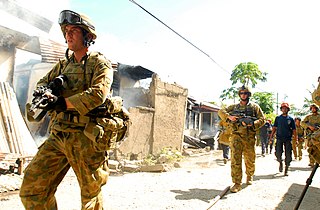
A battalion is a military unit, typically consisting of three hundred to one thousand soldiers commanded by a lieutenant colonel and subdivided into a number of companies, each typically commanded by a major or a captain. The typical battalion is built from three operational companies, one weapons company and one headquarters company. In some countries, battalions are exclusively infantry, while in others battalions are unit-level organisations.

The Royal Australian Regiment (RAR) is the parent administrative regiment for regular infantry battalions of the Australian Army and is the senior infantry regiment of the Royal Australian Infantry Corps. It was originally formed in 1948 as a three battalion regiment; however, since then its size has fluctuated as battalions have been raised, amalgamated or disbanded in accordance with the Australian government's strategic requirements. Currently, the regiment consists of seven battalions and has fulfilled various roles including those of light, parachute, motorised and mechanised infantry. Throughout its existence, units of the Royal Australian Regiment have deployed on operations in Japan, Korea, Malaya, Borneo, Vietnam, Somalia, Rwanda, Cambodia, East Timor, the Solomon Islands, Iraq and Afghanistan.

6th Battalion, Royal Australian Regiment is a mechanised infantry battalion of the Australian Army. It was originally raised in Brisbane, Queensland, on 6 June 1965 and has since then served in a number of overseas deployments and conflicts including South Vietnam, East Timor, Iraq and Afghanistan. During the Vietnam War, the battalion earned a US Presidential Unit Citation from the United States when members from 'D' Company participated in the Battle of Long Tan on 18–19 August 1966. The battalion is currently based at Gallipoli Barracks in Brisbane and forms part of the 7th Brigade.

The 1st Australian Task Force was a brigade-sized formation which commanded Australian and New Zealand Army units deployed to South Vietnam between 1966 and 1972. 1 ATF was based in a rubber plantation at Nui Dat, 8 kilometres (5.0 mi) north of Bà Rịa in Phuoc Tuy Province and consisted of two and later three infantry battalions, with armour, aviation, engineers and artillery support. While the task force was primarily responsible for securing Phuoc Tuy Province, its units, and the Task Force Headquarters itself, occasionally deployed outside its Tactical Area of Responsibility.

The 5th/7th Battalion, The Royal Australian Regiment (Mechanised) was a mechanised infantry battalion of the Australian Army. The battalion was based at Robertson Barracks in Holtze, Northern Territory and formed part of the 1st Brigade. It was formed in 1973 by linking both the 5th and 7th Battalions of the Royal Australian Regiment together and was disbanded 3 December 2006, as part of the expansion of the Australian Army, when the 5th and 7th Battalions of the Royal Australian Regiment were delinked into two separate battalions once again.

The 3rd Battalion, Royal Australian Regiment is a mechanised infantry battalion of the Australian Army, based in Kapyong Lines, Townsville as part of the 3rd Brigade. 3 RAR traces its lineage to 1945 and has seen operational service in Japan, Korea, Malaya, Borneo, South Vietnam, Rifle Company Butterworth, East Timor, the Solomon Islands, Afghanistan and Iraq.

1st Battalion, Royal Australian Regiment is a regular motorised infantry battalion of the Australian Army. 1 RAR was first formed as the 65th Australian Infantry Battalion of the 34th Brigade (Australia) on Balikpapan in 1945 and since then has been deployed on active service during the Korean War, the Malayan Emergency, the Vietnam War, Unified Task Force in Somalia, East Timor, Iraq War and Afghanistan. Additionally, the battalion has deployed on peacekeeping and other operations to a number of countries including Japan, Rifle Company Butterworth, Timor Leste, Solomon Islands, Tonga and the Philippines. 1 RAR remains one of the Australian Army's most readily deployed units sending individuals and detachments to domestic, regional and other enduring operations. The battalion is currently based in Coral Lines at Lavarack Barracks, Townsville, Queensland, where it forms part of the 3rd Brigade.

The Battle of Coral–Balmoral was a series of actions fought during the Vietnam War between the 1st Australian Task Force and the North Vietnamese People's Army of Vietnam (PAVN) 7th Division and Viet Cong (VC) Main Force units, 40 kilometres (25 mi) north-east of Saigon. Following the defeat of the PAVN/VC Tet offensive in January and February, in late April two Australian infantry battalions—the 1st and 3rd Battalions of the Royal Australian Regiment (RAR)—with supporting arms, were again deployed from their base at Nui Dat in Phước Tuy Province to positions astride infiltration routes leading to Saigon to interdict renewed movement against the capital. Part of the wider allied Operation Toan Thang I, it was launched in response to intelligence reports of another impending PAVN/VC offensive, yet the Australians experienced little fighting during this period. Meanwhile, the PAVN/VC successfully penetrated the capital on 5 May, plunging Saigon into chaos during the May Offensive in an attempt to influence the upcoming Paris peace talks scheduled to begin on the 13th. During three days of intense fighting the attacks were repelled by US and South Vietnamese forces, and although another attack was launched by the PAVN/VC several days later, the offensive was again defeated with significant losses on both sides, causing extensive damage to Saigon and many civilian casualties. By 12 May the fighting was over, and the PAVN/VC were forced to withdraw having suffered heavy casualties. US casualties were also heavy and it proved to be their most costly week of the war.

The 2nd Battalion, Royal Australian Regiment is an amphibious light infantry battalion of the Australian Army part of the 1st Division Amphibious Task Group based at Lavarack Barracks in Townsville.

Operation Astute was an Australian-led military deployment to East Timor to quell unrest and return stability in the 2006 East Timor crisis. It was headed by Brigadier Bill Sowry, and commenced on 25 May 2006 under the command of Brigadier Michael Slater. The operation was established at the request of East Timor's government, and continued under an understanding reached between Australia, East Timor, and the United Nations, with the United Nations Integrated Mission in East Timor supporting and helping to develop East Timor's police force. Other countries deploying soldiers to East Timor include Malaysia, New Zealand and East Timor's former colonial power Portugal, operating under independent command.

The 8th/9th Battalion, Royal Australian Regiment is a motorised infantry battalion of the Australian Army. It was originally formed in 1973 by linking together both the 8th and 9th Battalions of the Royal Australian Regiment. Over the next twenty-four years the battalion would remain on the Australian Order of Battle based at Enoggera Barracks in Brisbane, Queensland, until it was disbanded in 1997 amid a number of Defence-wide cutbacks introduced by the Howard government. In 2006 it was announced that the battalion would be re-raised as part of a plan to expand the size of the Army and since then it established itself as a fully deployable motorised infantry battalion as part of 7th Brigade.

The 5th Battalion, Royal Australian Regiment is a regular motorised infantry battalion of the Australian Army. Originally established in 1965 it would serve two tours of South Vietnam before it was linked with the 7th Battalion to form the 5th/7th Battalion, Royal Australian Regiment in 1973. In late 2006 the two units were de-linked, and 5 RAR again joined the Australian Army's order of battle in its own right. It has since served in Iraq, East Timor and Afghanistan.

The 7th Battalion, Royal Australian Regiment is a regular infantry battalion of the Australian Army. It was originally raised in 1965 as part of Australia's commitment to the Vietnam War and it eventually served two tours in Vietnam in 1967 and 1971. In 1973, following Australia's withdrawal from the conflict, the battalion was amalgamated with the 5th Battalion, Royal Australian Regiment to form the 5th/7th Battalion, Royal Australian Regiment.

The Battle of Gang Toi was fought during the Vietnam War between Australian troops and the Viet Cong. The battle was one of the first engagements between the two forces during the war and occurred when A Company, 1st Battalion, Royal Australian Regiment struck a Viet Cong bunker system defended by Company 238 in the Gang Toi Hills, in northern Bien Hoa Province. It occurred during a major joint US-Australian operation codenamed Operation Hump, involving the US 173rd Airborne Brigade, to which 1 RAR was attached. During the latter part of the operation an Australian rifle company clashed with an entrenched company-sized Viet Cong force in well-prepared defensive positions. Meanwhile, an American paratroop battalion was also heavily engaged in fighting on the other side of the Song Dong Nai.

Operation Coburg was an Australian and New Zealand military action during the Vietnam War. The operation saw heavy fighting between the 1st Australian Task Force and North Vietnamese People's Army of Vietnam (PAVN) and Viet Cong (VC) forces during the wider fighting around Long Binh and Bien Hoa.

The Battle of Hat Dich was a series of military actions fought between an allied contingent, including the 1st Australian Task Force and the People's Army of Vietnam (PAVN) and Viet Cong (VC) during the Vietnam War. Under the code name Operation Goodwood, two battalions from 1 ATF deployed away from their base in Phước Tuy Province, operating against suspected PAVN/VC bases in the Hat Dich area, in western Phước Tuy, south-eastern Biên Hòa and south-western Long Khánh provinces as part of a large allied sweep known as Operation Toan Thang II. The Australians and New Zealanders conducted sustained patrolling throughout the Hat Dich and extensively ambushed tracks and river systems in the Rung Sat Special Zone, occupying a series of fire support bases as operations expanded. Meanwhile, American, South Vietnamese and Thai forces also operated in direct support of the Australians as part of the division-sized action.
The Battle of Maehwa-San was fought for control of the hills and area around Maehwa mountain between the Hoengseong County and Wonju, between 7–12 March 1951, during the Korean War. The British Empire 27th British Commonwealth Brigade was tasked with eliminating the Chinese People's Volunteer Army (PVA) and Korean People's Army (KPA) forces occupying the area.
The Land Warfare Centre (LWC) is an Australian Army training establishment that is responsible for the provision of promotion courses to commissioned and non commissioned officers (NCOs) in an "all corps" setting. It was originally established during World War II at Canungra, Queensland, as the Jungle Training Centre to prepare troops for combat in the South West Pacific Area. During the 1950s and 1960s, the centre fulfilled a similar role, but since then has evolved to provide a broader spectrum of training courses with detachments at a number of bases across Australia.

Airborne forces raised by Australia have included a number of conventional and special forces units. During the Second World War the Australian Army formed the 1st Parachute Battalion; however, it did not see action. In the post-war period Australia's parachute capability was primarily maintained by special forces units. In the early 1980s a parachute infantry capability was revived which led to the Parachute Battalion Group forming in 1983 based on the 3rd Battalion, Royal Australian Regiment. In 1997, a full time commando regiment was raised that was able to conduct large-scale operations which matured during the 2000s. In 2011, 3 RAR relinquished the parachute role with the Army deciding to opt out of a conventional parachute capability in preference to a special forces large-scale parachute capability.
The Royal New Zealand Infantry Regiment contributed companies to the 1st Australian Task Force, deployed in Phước Tuy Province, Republic of Vietnam during the Vietnam War from 1967-1972.















